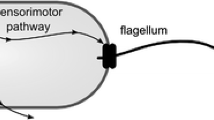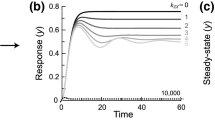Abstract
Perfect adaptation describes the ability of a biological system to restore its biological function precisely to the pre-perturbation level after being affected by the environmental disturbances. Mathematically, a biological system with perfect adaptation can be modelled as an input-output nonlinear system whose output, usually determining the biological function, is asymptotically stable under all input disturbances concerned. In this paper, a quite general input-output mathematical model is employed and the ‘functional’ of biological function (FBF) - output Lyapunov function - is explored to investigate its perfect adaptation ability. Sufficient condition is established for the systems with FBF to achieve perfect adaptation. Then a sufficient and necessary condition is obtained for the linear systems to possess an output Lyapunov function. Furthermore, it is shown that the ‘functional’ of receptors activity exists in the perfect adaptation model of E. coli chemotaxis. Different with the existing mathematical surveys on perfect adaptation, most of which are based on the standpoint of control theory, we first investigate this problem using ways of nonlinear systems analysis.
Similar content being viewed by others
References
Barkai N and Leibler S, Robustness in simple biochemical networks, Nature, 1997, 387: 913–917.
François P and Siggia E D, A case study of evolutionary computation of biochemical adaptation, Physical Biology, 2008, 5: 026009.
Endres R G and Wingreen N S, Precise adaptation in bacterial chemotaxis through ‘assistance neighborhoods’, PNAS, 2006, 103(35): 13040–13044.
Berg H C and Brown D A, Chemotaxis in Excherichia coli analysed by three-dimensional tracking, Nature, 1972, 239: 500–504.
Block S M, Segall J E, and Berg H C, Adaptation kinetics in bacterial chemotaxis, Journal of Bacteriology, 1983, 154: 312–323.
Mello B A and Tu Y, Quantitative modeling of sensitivity in bacterial chemotaxis: The role of coupling among different chemoreceptor species, PNAS, 2003, 100: 8223–8228.
Levchenko A and Iglesias P A, Models of eukaryotic gradient sensing: Application to chemotaxis of amoebae and neutrophils, Biophysical Journal, 2002, 82: 50–63.
Mettetal J T, Muzzey D, Gomez-Uribe C, and van Oudenaarden A, The frequency dependence of Osmo-adaptation in Saccharomyces cerevisiae, Science, 2008, 319: 482–484.
Muzzey D, Gomez-Uribe C A, Mettetal J T, and van Ouderaarden A, A systems-level analysis of perfect adaptation in Yeast osmoregulation, Cell, 2009, 138: 160–171.
Yi T M, Huang Y, Simon M I, and Doyle J, Robust perfect adaptation in bacterial chemotaxis through integral feedback control, PNAS, 2000, 97(9): 4649–4653.
Sontag E D, Adaptation and regulation with signal detection implies internal model, System and Control Letters, 2003, 50: 119–126.
Karafyllis I, Pepe P, and Jiang Z P, Global output stability for systems described by retarded functional differential equations: Lyapunov characterizations, European Journal of Control, 2008, 6: 516–536.
Khalil H K, Nonlinear Systems, Third Edition, Publishing House of Electronics Industry, Beijing, 2007.
Huang L, Theoritical Basis of Stability and Robustness, Science Press, Beijing, 2003.
Iglesias P A and Levchenko A, A general framework for achieving integral control in chemotactic biological signaling mechanisms, Proceedings of the IEEE Conference on Decision and Control, Orlando, 2001, 843–848.
Kollmann M, Løvdok L, Bartholomé K, Timmer J, and Sourjik V, Design principles of a bacterial signalling network, Nature, 2005, 438: 504–507.
Behar M, Hao N, Dohlman H G, and Elston T C, Mathematical and computational analysis of adaptation via feedback inhibition in signal transduction pathways, Biophysical Journal, 2007, 93: 806–821.
Ma W W, Trusina A, EI-Samad H, Lim W A, and Tang C, Defining network topologies that can achieve biochemical adaptation, Cell, 2009, 138: 760–773.
Ni X Y, Drengstig T, and Ruoff P, The control of the controller: Molecular mechanisms for robust perfect adaptation and temperature compensation, Biophysical Journal, 2009, 97: 1244–1253.
Ang J, Bagh S, Ingalls B P, and McMillen D R, Considerations for using integral feedback control to construct a perfectly adapting synthetic gene network, Journal of Theoretical Biology, 2010, 266: 723–738.
Alon U, Surette M G, Barkai N, and Leibler S, Robustness in bacterial chemotaxis, Nature, 1999, 397: 168–171.
Mello B A and Tu Y, Perfect and near-perfect adaptation in a model of bacterial chemotaxis, Biophysical Journal, 2003, 84: 2943–2956.
EL-Samad H, Goff J P, and Khammash M, Calcium homeostasis and parturient hypocalcemia: An integral feedback perspective, Journal of Theoretical Biology, 2002, 214: 17–29.
Guo J, Zhang J F, and Zhao Y L, Adative tracking of a class of first-order systems with binaryvalued observations and fiexed thresholds, Journal of Systems Science and Complexity, 2012, 25(6): 1041–1051.
Wang P and Lü J H, Control of genetic regulatory networks: opportunities and challenges, Acta Automatica Sinica, 2013, 39(12): 1969–1979.
Yu J B and Wu Y Q, Global asymtotic regulation control for nonlinear systems with iISS inverse dynamics, Journal of Systems Science and Complexity, 2012, 25(2): 249–267.
Parent C A and Devreotes P N, A cell’s sense of direction, Science, 1999, 284: 765–770.
Author information
Authors and Affiliations
Corresponding author
Additional information
This paper was recommended for publication by Editor LÜ Jinhu.
Rights and permissions
About this article
Cite this article
Su, W. Perfect adaptation of general nonlinear systems. J Syst Sci Complex 29, 61–73 (2016). https://doi.org/10.1007/s11424-015-4053-9
Received:
Revised:
Published:
Issue Date:
DOI: https://doi.org/10.1007/s11424-015-4053-9




